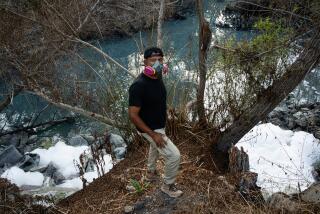Three Sites Off O.C. Coast High on Polluted List
- Share via
Tourist brochures of Orange County boast of the sandy expanses of Huntington Beach and the sail-studded coast of Newport Beach, not of contaminated mud lurking beneath the water.
But three areas along the county’s coast have caught the attention of federal experts conducting a survey of sediment contamination nationwide.
The three sites--off Huntington Beach, Newport Bay and the Dana Point area--rank among 10 in California the U.S. Environmental Protection Agency has pinpointed as areas of concern.
Public agencies detected PCBs, DDT, copper, arsenic and other contaminants in sediment at those sites during tests conducted in the 1980s and early 1990s. The EPA used those findings in compiling its massive coast-to-coast inventory that is focusing new attention on sediment problems.
Polluted sediment does not pose a direct threat to swimmers and surfers, EPA officials said. But it can accumulate in mud-dwelling creatures such as crabs and worms, then spread through the food chain, sometimes prompting warnings that certain fish are unsafe to eat.
The Orange County sites resemble a number of spots across the country, known to have contaminated sediment, said Jim Keating, the EPA scientist overseeing the study in Washington.
Since Orange County was once largely agricultural, experts are not surprised that the now banned pesticide DDT continues to turn up in its sediment. And runoff from industrial sites can taint offshore sand and silt with PCBs, metals and other pollutants.
Huntington Beach was the sole county site showing a higher risk to human health, due to findings of PCBs in barred sand bass in 1987, 1989 and 1991.
Most of the high Huntington Beach readings are clustered several miles off the coast, especially on either side of a major sewer release pipe. The 4 1/2-mile pipe releases an average of 240 million gallons of treated sewage daily into the ocean off Huntington Beach.
Some local officials criticized the survey for relying on old information. They note some data was gathered as far back as the early 1980s and does not reflect that some contamination levels have decreased locally in the years since. They are awaiting a report to be released later this year that will provide more current information about contamination off the Southern California coast.
The EPA study relied on tests conducted by a number of public agencies. For instance, in studying sediment off Huntington Beach, EPA relied heavily on testing conducted by the County Sanitation Districts of Orange County, which provides sewage treatment to most county residents.
A 1995 report from the district says that testing found “significant declines” in contaminant concentrations, especially in metals, from 1985 to 1995. In addition, levels of DDT and PCBs in some fish tissues have decreased since the late 1980s, the report states.
“In general, things are getting better, not worse,” said Nancy J. Wheatley, director of technical services at the districts.
Although DDT and PCBs were banned in the United States in the 1970s, they persist in the environment, proving two of the most common contaminants detected in the EPA study.
“If you go looking in sediments off any shore in the country . . . this stuff was so ubiquitous, you ought to check your instruments if you don’t find any, which isn’t to say it isn’t a problem,” Wheatley said.
Officials at the EPA regional office in San Francisco downplayed the findings of PCBs in fish off Huntington Beach.
“We don’t think there’s any need for people to be concerned about fish out there,” said EPA scientist Terry Fleming.
Still, the general health of the Huntington Beach marine environment could attract increased public attention in coming months as EPA determines how much treatment Orange County sewage really needs.
The sanitation districts are operating under an EPA waiver that allows the discharge of sewage that has not received treatment as stringent as that required under the Clean Water Act.
District officials applied for a new waiver in 1989 so they could continue that practice, and after a multitude of delays the EPA is expected to make a decision later this year.
But stepped-up treatment of sewage would not solve the problem of sediment contamination, especially since chemicals like DDT and PCBs have already accumulated off the coast, Wheatley said.
New details about the extent of local contamination will be made public later this year with the completion of a $3-million study coordinated by the Southern California Coastal Water Research Project, a Westminster-based agency funded largely by sanitation districts and other government agencies.
Tests were conducted in 1994 at 250 sites throughout the region, including about two dozen in Orange County.
The report, due out later this year, is expected to be the most detailed to date on sediment conditions along Southern California’s coast, said Stephen Weisberg, the research project’s executive director.
More to Read
Sign up for Essential California
The most important California stories and recommendations in your inbox every morning.
You may occasionally receive promotional content from the Los Angeles Times.










